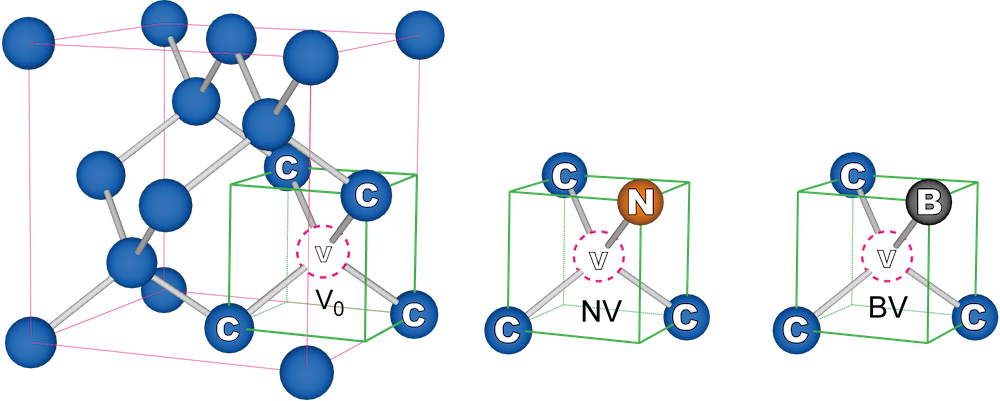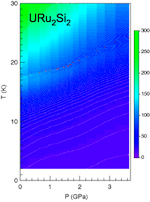The Mysterious Softening Discovered in Diamond
-- A New Possibility for Enhancing the Performance of Next-Generation Quantum Computing Technology --
Points
>> The elastic modulus of synthetic diamond single crystals was precisely measured at ultra-low temperatures approaching absolute zero (~0.02 Kelvin).
>> All three types of diamonds—each differing in origin—exhibited a softening behavior below 1 Kelvin.
>> The origin of this anomalous softness is suggested to be previously unidentified lattice defects present at concentrations as low as parts per billion (ppb).

Fig. 1 Crystal Structure of Diamond and Various Atomic Vacancies
Abstract
A research team led by Prof. Tatsuya Yanagisawa from Hokkaido University, together with scientists from Dresden High Magnetic Field Laboratory, HZDR and TU Dresden, as well as Niigata and Kyoto Universities, has made a surprising discovery: synthetic diamond becomes softer when cooled to extremely low temperatures, close to absolute zero. This unexpected behavior hints at the presence of a new kind of quantum state inside the diamond—something that could play an important role in future technologies like quantum computers and ultra-sensitive sensors.
Diamonds aren’t just beautiful—they’re also known for being incredibly hard and excellent at conducting heat. Because of these features, they’re used in many advanced technologies. Synthetic diamonds, which are made in a lab and contain very few defects or impurities, are especially promising materials. They’re already being studied for their potential in high-tech fields like quantum information. In particular, a special kind of defect in diamonds, called an NV center, is attracting attention for its ability to work as a tiny, super-sensitive sensor or quantum bit (qubit), even at room temperature.
Until now, most research has focused on diamonds that were deliberately irradiated by particle beams to create these defects. But what happens in pure, non-irradiated diamonds at extremely low temperatures was still a mystery—especially when it comes to their elasticity, or how soft or hard they are.
In this study, the team examined three types of lab-grown diamonds using high-precision ultrasound wave techniques. They found, for the first time, that all three types became slightly softer—by about 0.01%—when cooled below 1 Kelvin (that’s about minus 272 degrees Celsius). This softening seems to be linked to a hidden quantum state in the diamond, one that behaves like a kind of tiny electric field shape (called an electric quadrupole).
Interestingly, this phenomenon can’t be explained by any known defects like nitrogen or boron, meaning the exact cause is still unknown. If future research can reveal more about this mysterious behavior, it could help scientists create better quantum devices with fewer errors—and might even lead to big improvements in the performance of quantum computers and sensors in the years to come.
This research was published as an open-access article in the online edition of the Journal of the Physical Society of Japan (Letters) on 10th, June 2025.
Backgrounds
Synthetic diamond is gaining attention as a promising material for cutting-edge technologies, including quantum computers, highly sensitive quantum sensors, and next-generation power semiconductor devices. Inside a diamond’s crystal structure, there are tiny imperfections called “color centers”—combinations of impurity atoms and atomic vacancies. These defects affect the color of the diamond, depending on the type and concentration of impurities.
These imperfections naturally form due to the high-temperature and high-pressure conditions used to grow synthetic diamonds. While researchers can control the number of such defects to some extent, completely eliminating them is not possible.
Scientists have long studied the quantum properties of these color centers using techniques like laser spectroscopy and electron spin resonance. These methods focus on observing the electric dipole and spin degrees of freedom of the electrons associated with the defects. In most studies, researchers deliberately introduce defects by irradiating the diamonds with high-energy electron or quantum beams to increase the number of color centers. One well-known example is the nitrogen-vacancy (NV) center, a defect formed by a nitrogen atom next to a single missing carbon atom. NV centers are intensely studied for their magnetic quantum properties, which make them suitable for use as qubits in quantum computers.
On the other hand, a neutral single atomic vacancy (V0)—where a single carbon atom is missing without any surrounding impurities—is colorless and transparent. Its quantum ground state is difficult to observe directly using laser-based experiments. Only indirect observation is possible, through excited states that lie about 1.6 eV above the ground state. As crystal growth techniques have improved, some diamonds now have vacancy concentrations below 1 part per billion (ppb), making direct observation of such defects nearly impossible.
In addition to V0, there are many other types of lattice defects, and theoretical studies using first-principles calculations have suggested various possible ground states. However, for non-irradiated diamonds, these states remain mysterious. As quantum devices become increasingly miniaturized, there is growing concern that invisible defects—those undetectable by optical or magnetic measurements—could impact device performance and yield.
Interestingly, in silicon crystals, which share the same crystal structure as diamond, researchers have already discovered that atomic vacancies can exhibit an “electric quadrupole” degree of freedom, causing a softening effect at ultra-low temperatures. Until now, no such experiments had been performed on single-crystal diamond at cryogenic temperatures.
To address this, Prof. Yanagisawa and his international research team conducted pioneering experiments to examine this possibility, using ultrasonic techniques on diamond cooled to extremely low temperatures.
Research Summary and Key Findings
The research team combined a highly sensitive technique called ultrasonic phase comparison, which can detect electric quadrupole effects of electrons in solids, with advanced cryogenic and high magnetic field equipment from both Japan and overseas. Using this setup, they precisely measured the elastic stiffness constants—a measure of how hard a material is—of three different types of synthetic diamond single crystals. These included Type IIa diamonds made by HPHT and CVD methods, and Type Ib diamonds made by the HPHT method. Importantly, none of these diamonds were irradiated, meaning they had not been intentionally damaged to introduce defects.
The experimental results are shown in Fig. 2. In all three diamond samples, the elastic constant known as C₄₄ decreased as the temperature dropped below 1 Kelvin. In other words, the diamonds became softer at ultra-low temperatures, and the softening followed a clear inverse relationship with temperature. This behavior has never been observed before and cannot be explained by any existing models of known quantum ground states associated with lattice defects in diamond.

Fig. 2 Temperature Dependence of the Elastic Constant C44 in Diamond
These findings strongly suggest that a previously unidentified quantum ground state—originating from an unknown defect—is present in pure, non-irradiated diamond. This state appears to have a special property called T₂ symmetry, which gives rise to a type of quantum response known as an electric quadrupole degree of freedom.
Furthermore, analysis of the data indicates that the concentration of the defect responsible for this phenomenon is extremely low—at the level of parts per billion (ppb). Despite being so rare, these defects still had a measurable impact, highlighting the incredible sensitivity of the experimental method and the subtlety of quantum behavior in diamond.
Future Outlook
This study provides strong evidence that electric quadrupole behavior exists in diamond, suggesting the presence of an unknown quantum ground state. However, the exact origin of this state remains unclear. Further research will be essential to fully understand the physics behind this phenomenon.
The research team plans to apply their precise ultrasonic measurement techniques—which work under extremely strong magnetic fields and ultra-low temperatures—to diamonds grown under various conditions. Their goal is to uncover the true nature of this mysterious quantum state.
In the long run, these efforts could lead to better ways of controlling and evaluating defects in synthetic diamonds. This, in turn, may help reduce errors in diamond-based quantum devices, paving the way for more reliable and efficient quantum computers and sensors in the future.
Acknowledgments
This research was supported by JSPS KAKENHI (Grant Nos. JP23H04868, JP21KK0046, JP22K03501, and the Toyota Physical and Chemical Research Institute under the 2021 Toyota Riken Scholar Collaborative Research Program (Phase 1). We acknowledge support from the DFG through the Würzburg-Dresden Cluster of Excellence on Complexity and Topology in Quantum Matter - ct.qmat (EXC 2147, project-id 390858490) and from the HLD at HZDR, a member of the European Magnetic Field Laboratory (EMFL). Nippon Sheet Glass Foundation for Materials Science and Engineering: Research Grant Program.
Publication Information
Title of the Paper: Elastic Softening in Synthetic Diamonds
Authors: Tatsuya Yanagisawa¹, Rua Hibino¹, Hiroyuki Hidaka¹, Hiroshi Amitsuka¹, Toshiyuki Tajima², Mitsuhiro Akatsu³, Yuichi Nemoto⁴, Sergei Zherlitsyn⁵, Joachim Wosnitza⁵,⁶
Affiliations:
¹Faculty of Science, Hokkaido University
²Graduate School of Engineering, Kyoto University
³Department of Physics, Faculty of Science, Niigata University
⁴Graduate School of Science and Technology, Niigata University
⁵Hochfeld-Magnetlabor Dresden (HLD), Helmholtz-Zentrum Dresden-Rossendorf
⁶Technische Universität Dresden
Journal: Journal of the Physical Society of Japan (Letters)
DOI: 10.7566/JPSJ.94.073602
Date of Publication: June 10th, 2025 (Japan Standard Time, online release)
For inquiries about this research:
Prof. Tatsuya Yanagisawa
Faculty of Science, Hokkaido University
Phone: +81-11-706-4422
Email: tatsuya@phys.sci.hokudai.ac.jp
Lab Website: https://phys.sci.hokudai.ac.jp/LABS/kyokutei/vlt/
Press Contact:
Public Relations Division
General Affairs and Planning Department, Hokkaido University
Kita 8-jo Nishi 5-chome, Kita-ku, Sapporo 060-0808, Japan
Phone: +81-11-706-2610
Email: kouhou@jimu.hokudai.ac.jp





